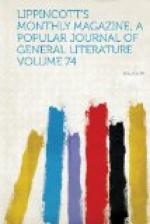On “Araby’s plains” I saw for the first time the beautiful wild palm, the “lighthouse of the desert,” always an object of intense desire to the weary traveler as he traverses those sterile regions, for as it looms up in the distance, sometimes in groups, but more generally standing in solitary grandeur near a tiny bubbling spring, its waving plumes tell him not only of shelter and needed rest, but of water also to bathe his tired limbs and quench the burning thirst that oppresses him almost to death. Should the friendly tree prove a date-palm, he will find food also—a dainty repast of ripe, golden fruit, wholesome and nourishing—ready prepared to his hand. But, after all, to a traveler over those sterile regions water is the grand desideratum, and this he is sure to find in the vicinity of the wild palm. The Bedouins, who consider it beneath their dignity to sow or reap, gather the date where they can find it growing wild; but the Arabs of the plains cultivate the tree with great care and skill, thus improving the size and flavor of the fruit, and producing some twenty or more varieties. In some they have succeeded in doing away with the seed altogether; and the seedless dates, being very large and delicately-flavored, bring always the highest price in the market. Date-honey is made by expressing the juice of the fresh fruit, and the luxury of fresh dates may be enjoyed through the entire year by keeping them in tight vessels, covered over with this honey. Date-flour, made by exposing the ripe fruit to the heat of the sun until sufficiently dry to be ground into fine powder, furnishes the ordinary sustenance of the Arabs in their frequent journeys across the deserts. This is food in its most condensed form, easily carried and needing no cooking. It is simply moistened with a little water, and so eaten. But the value of the date tree is by no means confined to the fruit. An agreeable beverage, known as palm wine, is drawn from the trunk by tapping; the trunks of the old trees make excellent timber; the leaves are used for hats and baskets; and the fibrous part, when stripped out, makes twine and ropes. Even the stones are of use—the fresh ones for planting, and the dried are turned to account—in Egypt for cattle-feed, in China for the manufacture of Indian ink, and in Spain for making the tooth-powder known as “ivory black.” The date is indigenous to both Asia and Africa: it was introduced into Spain by the Moors, and some few trees are still found even in the south of France. But the most extensive forests are those of the Barbary states, where they are sometimes miles in length. When growing thus in groves the palms are very beautiful, their towering crests waving in unison as they seem to form an immense natural temple, about which vines and creepers wreath their graceful tendrils, while birds of varied plumage sing their matin and vesper songs, plucking meanwhile the golden fruit that grows in clusters at the very summit of the tree. The Arabs’ mode of




